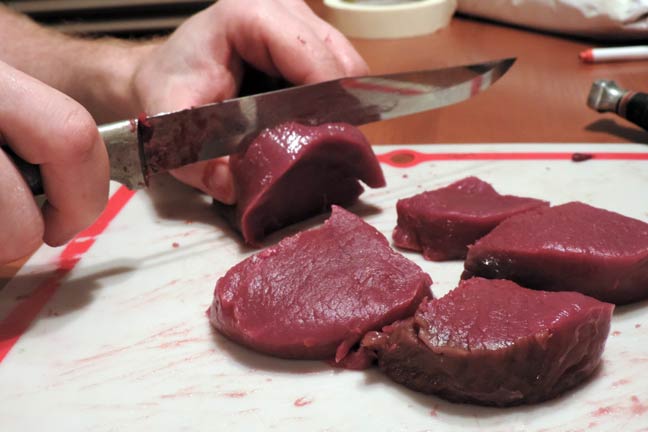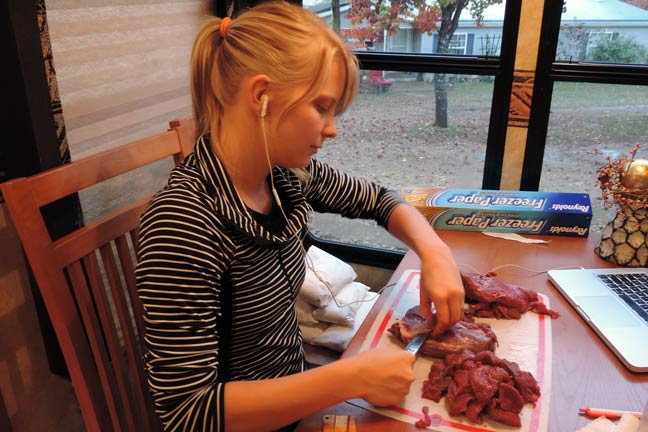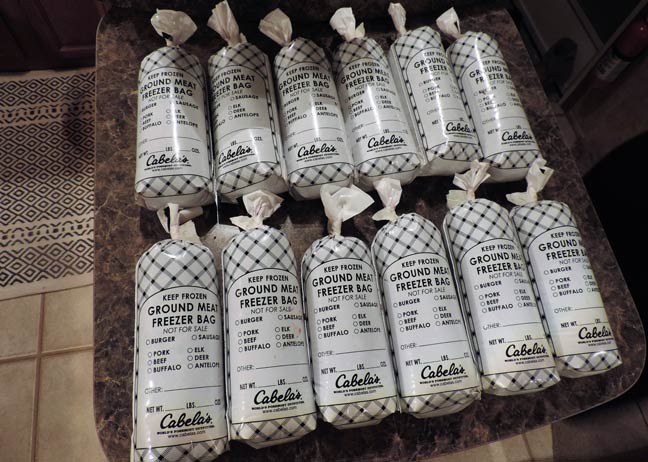Identifying and Cooking Cuts of Venison
0
Harvesting a deer secures a sizeable supply of delicious red meat. How that meat is handled and cooked, and by whom, depicts how well it will serve up as the main entrée next time you invite guests over for a wild-game dinner.

If you’ll be transporting your deer to a suitable skinning and butchering location, remove the entrails by field-dressing your deer immediately after the kill. Of course, field-dressing is unnecessary if you’ll be packing out the meat.
Of course, few hunters are experts at butchering and processing deer. So, most take the easy route – they drop harvested deer off at a meat-processing plant. In the past, I’ve done this myself, but these questions invariably linger: How is the meat handled? How sanitary are the tools and surfaces the meat contacts? Is the meat handled along with another hunters’ venison, or is each deer processed individually? For that matter, am I even getting my own deer meat back, or am I simply getting “venison?”
The thought of getting another hunter’s venison, or even a portion of it, repulses me. I handle deer meat as pridefully and carefully as possible because, again, how meat is handled determines its table quality.
If the questions I referenced above haunt you each time you take a deer to the butcher, perhaps you should consider butchering and processing your own deer from now on.
Getting Started
If you’ve never done it, removing usable meat chunks from a deer carcass can seem confusing. However, you need not be an expert to do it. First, you must know what cuts are good for specific dishes in order to harvest them correctly and in the right portions. Then, you must know where each cut is located.
If you’ve never done it, removing usable meat chunks from a deer carcass can seem confusing. However, you need not be an expert to do it. First, you must know what cuts are good for specific dishes in order to harvest them correctly and in the right portions. Then, you must know where each cut is located.
Let’s review the cuts, where each is located, and my favorite recipe for each cut.
Loins (AKA — Backstraps)
The loins are the most highly accoladed venison cut, and for good reason. These are the muscle bands that set along either side of the spine, extending from the bottommost vertebra up to the scapula. To harvest each one, cut along the spine starting by the scapula and working down to the last vertebra. Then, simply pull on the band of muscles with one hand and cut it free from the backbones with a sharp knife.
The loins are the most highly accoladed venison cut, and for good reason. These are the muscle bands that set along either side of the spine, extending from the bottommost vertebra up to the scapula. To harvest each one, cut along the spine starting by the scapula and working down to the last vertebra. Then, simply pull on the band of muscles with one hand and cut it free from the backbones with a sharp knife.

A venison loin is cut into steaks. Cut across the meat grain to ensure tender, non-chewy loin steaks.
My favorite way to prepare venison loins is a recipe called chicken fried steak. Slice the loin into ¼-inch-thick medallions, then roll them in flour. Next, dunk them in an egg/milk mixture, then roll in Ritz cracker crumbs seasoned with a salty/peppery steak seasoning. Fry in butter on medium/high heat until done to your liking.
Tenderloins
The aptly named tenderloins are found inside the deer’s chest cavity along either side of the spine. If you’ve field-dressed your deer, then you can easily nab these tasty gems from inside the chest cavity. If you’re caping, quartering and packing out your deer, then you can cut in through the back behind the rearmost rib. Insert your fingers and feel for the bands of muscles. Work carefully with your knife and fingers to retrieve the tenderloins without the hassle of field-dressing duties.
The aptly named tenderloins are found inside the deer’s chest cavity along either side of the spine. If you’ve field-dressed your deer, then you can easily nab these tasty gems from inside the chest cavity. If you’re caping, quartering and packing out your deer, then you can cut in through the back behind the rearmost rib. Insert your fingers and feel for the bands of muscles. Work carefully with your knife and fingers to retrieve the tenderloins without the hassle of field-dressing duties.

Becca McDougal, the author’s wife, cuts venison into chunks sized appropriately for the McDougal’s meat grinder.
Tenderloins also make delicious chicken fried steak, but sometimes there’s nothing like a tenderloin cooked on a charcoal grill with Weber Chicago Steak Seasoning. I sear the outside edges, then let the tenderloin cook until only slightly pink in the middle.
Roasts
The roast is the upper portion of the rump, although a roast can be cut into steaks or even ground, if you wish. Discreet tissue lines separate bands of muscles on the hind quarters, and any sizeable chunk of red meat you harvest from the hind quarters will make an excellent roast. Work your knife carefully along the tissue lines to remove roasts in large chunks.
The roast is the upper portion of the rump, although a roast can be cut into steaks or even ground, if you wish. Discreet tissue lines separate bands of muscles on the hind quarters, and any sizeable chunk of red meat you harvest from the hind quarters will make an excellent roast. Work your knife carefully along the tissue lines to remove roasts in large chunks.
My favorite way to prepare a roast is to place it in a slow cooker with carrots and potatoes. I cook on low heat until the meat is fall-apart tender. By then, the potatoes and carrots might be overcooked, so consider adding them to the slow cooker two hours after you add the roast. Incorporate savory seasonings, and you’ll have a hearty and fulfilling dinner. I occasionally cut large roasts into 1-inch cubes to be slow cooked in gravy for a beef-tip equivalent served over mashed spuds.
Steaks
The band of muscles between the hock and the rump roasts on the rear portion of the back leg is considered the “steak.” The front portion of the back leg is considered the sirloin steak. Once these chunks are harvested, slice across the muscle grain into steaks of desired thickness.
The band of muscles between the hock and the rump roasts on the rear portion of the back leg is considered the “steak.” The front portion of the back leg is considered the sirloin steak. Once these chunks are harvested, slice across the muscle grain into steaks of desired thickness.
Steaks can be grilled or pan-fried, but in my opinion, nothing beats a charcoal-grilled steak seasoned with a Chicago Steak Seasoning or equivalent.
Shanks
The tendon-strung muscles on the forelegs can be used, but are good for little other than stew meat. Once deboned, cut into cubes, then cook via slow cooker until the tendons loosen completely and the meat falls apart when stabbed with a fork.
The tendon-strung muscles on the forelegs can be used, but are good for little other than stew meat. Once deboned, cut into cubes, then cook via slow cooker until the tendons loosen completely and the meat falls apart when stabbed with a fork.
Scrap
Within reason, I harvest as much lean scrap meat as possible. This can be ground, or it can be turned into jerky or sausage. Most of it comes from the neck, brisket and front shoulders. Remember, any red scrap counts toward the final weight of meat harvested.
Within reason, I harvest as much lean scrap meat as possible. This can be ground, or it can be turned into jerky or sausage. Most of it comes from the neck, brisket and front shoulders. Remember, any red scrap counts toward the final weight of meat harvested.

The author sends chunked venison through a Weston meat grinder and directly into a 1 ½-pound Cabela’s burger bag.
I use a Weston electric meat grinder to grind all scrap meat at home. I don’t end up with enough scrap meat for a year supply of ground venison, so I normally grind up most of the roast meat, too. My wife and I use ground venison more than any other type of meat, so I try to have as much on hand as possible.
We occasionally make jerky from ground venison using a jerky gun, but we also make lots of burgers, taco meat, chili and meatloaf with it.
Closing Thoughts
As a final caution, I trim fat, tendons and silver skin from all cuts (even the scrap meat). This avoids a “tallowy” flavor and ensures the meat is as tender as possible. Always keep the meat cooled, and be sure to wrap cuts in freezer paper, or store them in vacuum-sealed bags to deflect freezer-burn.
As a final caution, I trim fat, tendons and silver skin from all cuts (even the scrap meat). This avoids a “tallowy” flavor and ensures the meat is as tender as possible. Always keep the meat cooled, and be sure to wrap cuts in freezer paper, or store them in vacuum-sealed bags to deflect freezer-burn.

The McDougals use ground venison for burgers, taco meat and meatloaf. These 12 packages of ground venison were used up within a few months.
As you butcher, be sure to use a clean knife (not the one you field-dressed the animal with). Remove the hide quickly and keep the meat in a cool, dry environment. Always handle meat on sanitary surfaces, and get the meat frozen as soon as it’s packaged properly.
Most states have a minimum legal requirement for meat that must be harvested from game animals. Be sure to abide by the laws.
I’m not an expert butcher, but I’ve saved hundreds of dollars by butchering dozens of my own deer, plus I get the peace of mind knowing how the meat was handled from field to table. You can have that same satisfaction by butchering and cooking your own venison.
For a detailed illustration of cuts, please visit here.
Related posts:
Read more: http://www.bowhuntingmag.com/how-to/identifying-and-cooking-cuts-of-venison/#ixzz4yd8PiQlx

No comments:
Post a Comment